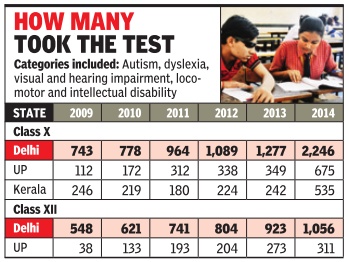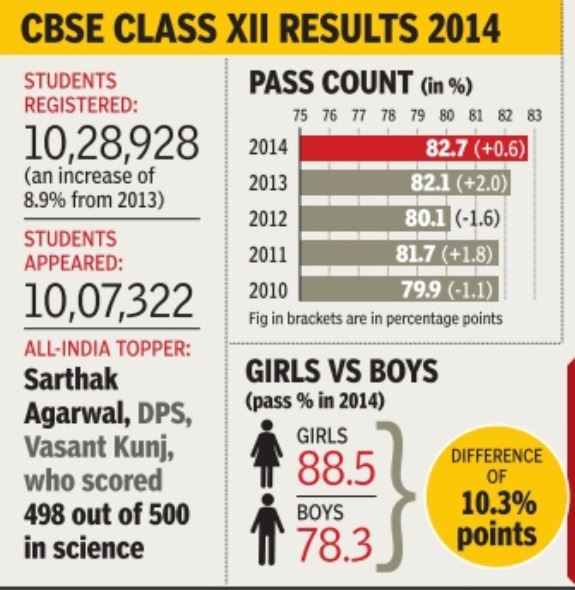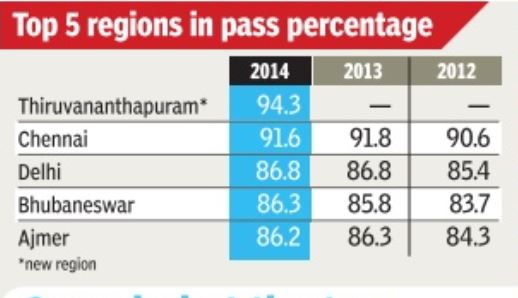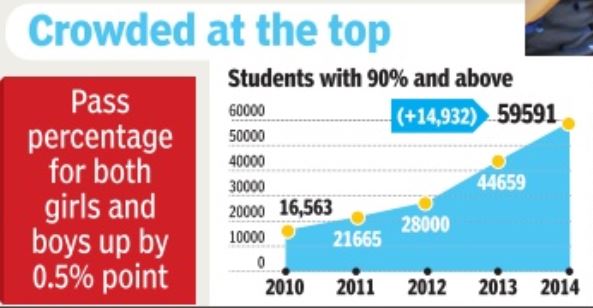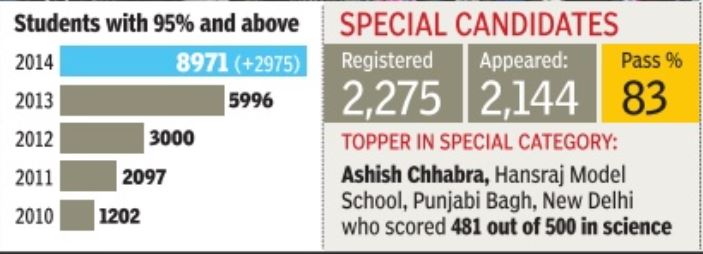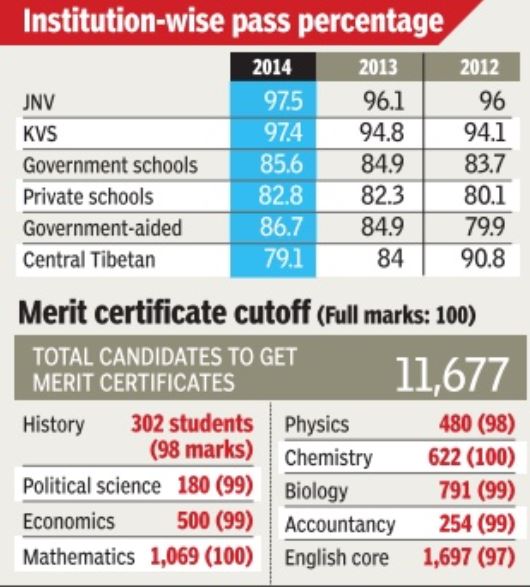Central Board of Secondary Education (CBSE)
(→Classes VI to IX) |
(→2015: CBSE exam pattern adopted for class 12(ISC)) |
||
| Line 130: | Line 130: | ||
“This is to gradually prepare the students for Class IX and higher classes where they will have to appear for exams for the entire syllabus. But it will happen gradually ,“ said Chaturvedi. | “This is to gradually prepare the students for Class IX and higher classes where they will have to appear for exams for the entire syllabus. But it will happen gradually ,“ said Chaturvedi. | ||
| − | ==2015: CBSE exam pattern adopted | + | ==Class XII== |
| + | ===2015: CBSE exam pattern adopted=== | ||
[http://epaperbeta.timesofindia.com/Article.aspx?eid=31808&articlexml=CISCE-rejigs-syllabus-follows-CBSE-exam-pattern-21112015027047 ''The Times of India''], Nov 21 2015 | [http://epaperbeta.timesofindia.com/Article.aspx?eid=31808&articlexml=CISCE-rejigs-syllabus-follows-CBSE-exam-pattern-21112015027047 ''The Times of India''], Nov 21 2015 | ||
Revision as of 23:49, 31 August 2017
This is a collection of articles archived for the excellence of their
content. You can update or correct this page, and/ or send graphs to the Facebook page, Indpaedia.com. All information used will be duly acknowledged. |
Affiliated schools
A growth: 1996-2013
No. of CBSE schools triple in 17 yrs
Hemali Chhapia Shah & Vinamrata Borwankar Mumbai:
TNN The Times of India Jun 18 2014
Almost half-a-dozen school boards—local, national and international—offer Indian students a choice of academic algorithms for careers ahead. The landscape of school education has for long promised a variety of options.
But of them all, CBSE (Central Board of Secondary Education), which was largely designed for those who moved home and could not be loyal to a state board, is picking up popularity across the nation.
In 1996-97, there were 4,843 affiliated schools to the CBSE board, which has grown to
15,000 institutes now, with most of the growth attributed to independent private schools, indicating the way the wind is blowing. While every year thousands of Indian parents find it tough to decide which board their child must sign up for, new school managements too face the same quandary when they start operations.
CBSE officials and school principals attribute the board’s popularity to its academic and administrative reforms which are student and school friendly. “Close to 98% of the schools that apply for affiliation are new institutes,” said an officer. Since 2005, the affiliation process is online and information at every stage is sent via electronic mail. “Also, the board is a national board, allowing parents to shift to just about anywhere in the country. The NCERT syllabus is also the most modern and wholesome one which is in tune with the times,” said a
CBSE administrative officer.
Little wonder then that in 2001-02 there were 6,293 affiliated schools, a number which increased to 13,898 in March 2012-13. Most of the growth came from independent institutes, the count of which went up from 3,483 in 2001-02 to 10,290 by the end of 2013.
Delhi has the largest number of CBSE schools, followed by UP, Haryana and Kerala.
Maharashtra, which has seen a 67% increase in the number of CBSE schools in the last three years, is home to over 500 institutes. “We have introduced and successfully implemented the continuous comprehensive evaluation system.
Norms for affiliated schools
Safety of school children
All school buses must now have speed governors dictating a limit of 40 km per hour, GPS and CCTV cameras, the Central Board of School Education (CBSE) directed in new guidelines for safety of school children issued.
Stating that the norms “should be scrupulously followed and complied with by all affiliated schools“, the board stated that the management and the head of the school will be held responsible for any lapse which could lead to disaffiliation.
The CBSE divided the guidelines into seven categories which include exterior and interior of the bus, manpower and facilities, permits, arrangements by school authorities and advisory to parents.
The CBSE in its circular stated that “the recent unfort unate instances reported in the media about callous approach by certain schools with respect to safety of children during transit to and from school have again agitated deep concern regarding the safety of schoolchildren. The time has come to make schools sensitive to this serious issue.“
On the buses' exterior, the Board said buses should be pa inted yellow with the school name prominently on both sides. `School bus' should be written prominently on the back and front of the vehicle and if it is a hired bus, “On school duty“ should be clearly written.
The board also stated that the driver's name, address, licence number, badge number and the telephone number of the school or bus owner and transport department's helpline numbers should be displayed at prominent places inside and outside the bus. In the buses' interiors, windows will have to be fitted with horizontal grills and mesh wire, and doors with reliable locks.
School authorities will also have to provide one mobile phone in each bus and ensure that the buses are not permitted to overtake any four-wheeler while carrying children.
Conduct of examinations
How papers are marked
A CBSE examiner's candid account of how papers are marked, June 4, 2017: The Times of India
I'm an assistant head examiner, so our job is to make sure the examiners have marked scripts fairly, in accordance with the CBSE's marking scheme.
But I'm truly shocked by the vagaries of the system and quality of the examiners.We've had to ask a couple of them to go back. Examiners are picked by the CBSE, from schools, but many , especially those who teach in government schools, seem to be unequipped to grade. Some students don't end up getting the marks they deserve, while the rote learners do well.
Of course, it's a lot of pressure, you have to do ten scripts the first day, twenty the second day and so on, and maintain an average of about 25. You're very poorly paid -around 25 per paper for Class X and 30 per paper for Class XII -so most examiners simply don't want to do this work.
This one gentleman was being very stubborn and marking harshly. I had to correct upwards in all his scripts; he simply refused to get the point. Then we figured out that he is an accountancy teacher, not economics, and didn't understand that a student could answer a question correctly without sounding exactly like the CBSE's prescribed marking scheme.That is just a guideline, not a bible. For instance, a student can answer a question about the price elasticity of demand by a formula or by an example, one has to understand the approach. We had to ask him to leave, finally. We had to ask another lady to go back because she was just giving marks without reading. The other problem is that the CBSE often frames its marking schemes poorly . In one set of the economics exam, one question was wrong; it expected you to find 12 values but only 8 were calculable. Now imagine a student doing this, obviously they would fumble, possibly scratch out the earlier correct answers. In such a situation where the question is wrong, they should automatically give full marks to the student, but instead they said, give marks only if the first few have been correctly answered. This is unfair.The questions are supposed to be framed by literate people, how can they go wrong like this?
There's been a lot of talk about moderation, but we correct our scripts only by the marking scheme. There is no general moderation, at least up to our level. We are not supposed to check for passing or failing, or give any grace marks. But it's true that some subjects seem to produce incredible results, like getting a perfect 100 in English. In economics though, that doesn't happen much, in the 1100 scripts from our centre, not a single student got a 100.
The real problem is that we are dealing with examiners who are not always equipped to do their jobs, so we end up with some arbitrary and unfair results.There needs to be a minimum bar to become an examiner, one has to have taught the subject at the Plus-Two level for at least two years.But this doesn't happen as many schools don't have such resources. This has to do with the general state of teaching across the country .None of my students want to be teachers themselves. But in the meanwhile, the examination system is clearly broken.
Disabled candidates
Jan 05 2015
Most disabled kids in CBSE exam from city
Shreya Roychowdhury
The largest number of disabled candidates appearing for classes X and XII evaluation under Central Board of Secondary Education (CBSE) is from Delhi.The state-wise count of students with disabilities, released by the Board also showed that the number of differently-abled students appearing for evaluation has been rising steadily . A total of 743 candidates appeared in Class X exam in 2009 in Delhi and more than double the figure appeared in 2014. There were no registrations of autistic students in Class X from 2009 to 2013 from Delhi, but there were five in 2014. Similarly, numbers of students with visual impairment or dyslexia have also increased significantly over the six years -from 214 to 403 in case of blind students and from 93 to 423 in case of those with dyslexia. For the Class XII exam, the biggest jump was in case of orthopedically challenged students. CBSE categorizes them as “handicapped“. In 2009, 272 mobility-impaired candidates from Delhi appeared for Class XII evaluations; the figure rose to 524 in 2014. The number of hearing-impaired students jumped from 25 in 2009 to 130 in 2014.
One of the reasons for the huge difference between Delhi and runners-up Uttar Pradesh, Kerala and Madhya Pradesh is that in Delhi majority of schools are CBSE-affiliated. There is no state board and government schools too come under CBSE.
“Inclusive education is strong in Delhi,“ George Abraham of NGO Score Foundation said adding, “There are more visually challenged students in mainstream schools in Delhi than in any other place in the country. It also depends on the support services, availability of reading material and trained teachers. Delhi is more education-friendly, more aware,“ he said. “Even CBSE is good at handling things here as regional officers are always well-equipped.“ He recalled the case of a student in Surat who was not allowed to use a computer to write his exam.“They were telling him to go to Ajmer. We managed it, but regional offices are not necessarily in sync with the headquarters.“
Madhumita Puri of Society for Child Development, Delhi, said most of the students who have been successfully appearing for these exams are either from private schools or from National Institute of Open Schooling (NIOS). “Sarva Shiksha Ab hiyan has helped and so has stricter implementation of 3% reservation in jobs,” Puri said, “The well-to-do always send their disabled children to school. Now, poor parents too have been making an effort.”
In case of Delhi, the number of students, who appeared for CBSE evaluation in Class X, is close to the num ber appearing in Class XII two years later.
A total of 743 students appeared in Class X evaluation in 2009 and 741 appeared in Class XII exam in 2011. Either the attrition rate is low with those completing Class X choosing to remain in school, or students from other states, where there is a dip in number, are moving in to Delhi.Puri said, “There is a huge migration of visually-impaired students into Delhi, but very little in the other categories.“
Examination formats
Classes VI to IX
2017-18 onwards
Manash Gohain, CBSE unveils new exam format for classes VI to IX, Mar 22, 2017: The Times of India
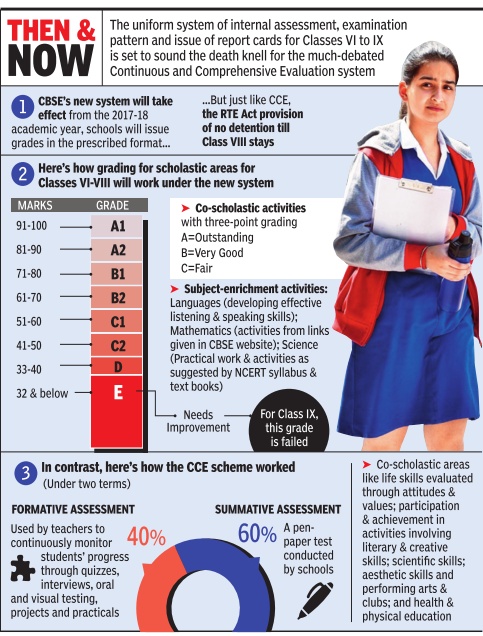
CCE Junked, Changes From Coming Year
The Central Board of Secondary Education has formally junked the continuous and comprehensive evaluation (CCE) scheme for classes VI to IX, being followed in affiliated schools since 2009. Replacing it from the coming academic year (2017-18) is a new format -`uniform system of assessment, examination and report card' -that aims at standardising teaching and evaluation across schools.
All students will be under a “uniform assessment“ process from Class VI onwards and schools will have to adhere to CBSE's template, from examinations to report cards, which will now bear the logo of the board.
CBSE said schools under its fold have been following various systems of assessment and examination in classes VI to IX. The changes being brought in are also linked to the restoration of the Class X board examinations from 2018, said board chairperson R K Chaturvedi.
The new format, he said, is a “gradual movement towards quality education through standardisation of teaching, assessment, examination and report card“.
Chaturvedi added that uniform standards had become imperative because disparities in the system were creating problems for students whenever they migrated to another school.
“With the increase in CBSE affiliated schools from 309 in 1962 to 18,688 at present, a uniform system will ensure easy migration of students within the CBSE schools and also ease their difficulties while seeking admissions in new schools,“ Chaturvedi said.
The new report cards for classes VI to VIII will be identical with rows which specify the terms, periodic, notebook, subject enrichment and half yearly yearly marks scored in each subject and the corresponding grades. It will also have co-scholastic assessment where students will be graded on a 3point scale. The format changes in Class IX where the report card will have scores of a single yearly term comprising a periodic test, notebook, subject enrichment and annual examination. The co-scholastic grading will be on a fivepoint grading scale.
Under the CCE scheme students were assessed based on two term-end `summative assessments' and four `formative assessments' (two each in each terms). Sixty percent of the assessment was pen-paper tests, while 40% formative assessment during the year was continuous evaluation by teachers based on various activities.
The new scheme too has two terms, but the pen-paper test weightage will be now 90%, which includes the 80 marks of the half yearly or yearly exam and 10 marks of the 20 marks set aside for periodic assessment in each term.
Each term will be of 100 marks of which 10 marks will be for note book submission and subject enrichment (five marks each) under periodic assessment. While the half-yearly (term 1) exams for all the classes from VI onwards will be based on syllabus covered till the exam time, the syllabus for yearly exams will have a slightly different format. These exams will in creasing cover more of term 1 syllabus, starting with 10% for Class VI, 20% for Class VII and 30% for Class VIII.
“This is to gradually prepare the students for Class IX and higher classes where they will have to appear for exams for the entire syllabus. But it will happen gradually ,“ said Chaturvedi.
Class XII
2015: CBSE exam pattern adopted
The Times of India, Nov 21 2015
CISCE rejigs syllabus, follows CBSE exam pattern
The Council for the Indian School Certificate Examination (CISCE) board revamped its syllabus, infrastructure and training methods, with an objective of centralising education. At its 58th annual meeting, the board decided to frame class 12 (ISC) question papers based on the CBSE pattern from 2018.
Sample question papers for the ISC exams in 2018 for physics, chemistry , biology and math have been prepared as per the CBSE pattern. For class 10 (ICSE), the syllabus for history , civics, geography , math and physics has been reviewed for 2018. This is to ensure it is relevant, flexible and meaningful in content.
The break-up of marks of the theory and practical components at the ISC level has been revised for the following subjects: Computer science, fashion designing, physical education, Indian music (Hindustani), Carnatic and Western music. The earlier figures of 50% (theory) and 50% (practical) have been changed to 70% and 30%, w.e.f 2016.
The sample papers for these subjects have already been sent to schools and are also available on the council website.
Examination reforms
Re-evaluation system abolished/ 2017
HC Had Slammed Board's Selective Policy In February
After three years of what was touted as the most radical exam reform by Central Board of Secondary Education, the board has decided to do away with the re-evaluation process completely . Several schools and students have called it a regressive step.
The board, however, is continuing with the verification (re-calculation) of marks, online application for which opens on Wednesday . If one doesn't apply for verification, they can't obtain a photocopy of the answersheets either.
Delhi high court had in February upheld a student's right to be re-evaluated in all subjects and questions. A bench of then Chief Justice G Rohini and Justice Sangita Dhingra Sehgal had also pointed out that students had the prerogative to get their answersheets re-evaluated to ensure proper assessment was done and that “it would lead to discontentment and frustration if the students who put in a lot of effort don't get the results they expect“.
On February 4, HC struck down the board's selective reevaluation policy that restricted students from availing the option in just 10 subjects and 10 questions per subject. The court termed CBSE's decision as “rather eccentric“ as it “first provided for the facility of re-evaluation to the candidates and, thereafter, put unreasonable restrictions“.
As long as the policy existed in the bylaws of CBSE, it could not whittle down and restrict the number of questions or subjects that could be re-evaluated, it noted.
In 2014, CBSE had decided to allow Class XII candidates to not only get a photocopy of their evaluated answersheets, but also seek re-evaluation instead of just a re-count of marks. It started with seven subjects -English, Hindi, physics, chemistry , mathematics, political science and eco nomics -which was later extended to 11subjects in 2015.
The principal of a private school in south Delhi said: “ A student is entitled to get the manuscript. After that if he she, or any expert, finds a mistake in evaluation, how can CBSE deny a remedy?“ Till 2016, a candidate first had to apply for verification of marks, followed by an application for photocopy of the answersheets. Finally , one could apply for re-evaluation. Now, “there will be no re-evaluation of any evaluated answer. However, if any answer has not been evaluated, the same would be reported by the candidate to respective regional offices of CBSE not later than seven days of receipt of the photocopy of the answerbook“.
The principal of another private school said: “The government talks of transparency and good governance, but this is another regressive step by CBSE. Re-evaluation helped many students in the last three years.“
TOIcame across a number of cases where re-evaluation helped rectify errors. For example, Vikas Kapoor (name changed), now a third-year history student at St Stephen's College, managed to make it to the college after his English score was increased from 90 to 95 after re-evaluation.
Grade inflation
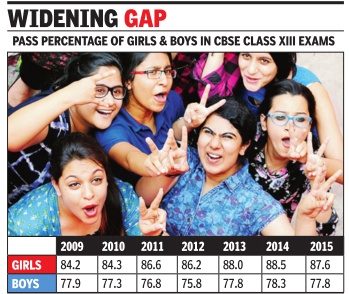
2009-16
See graphic.
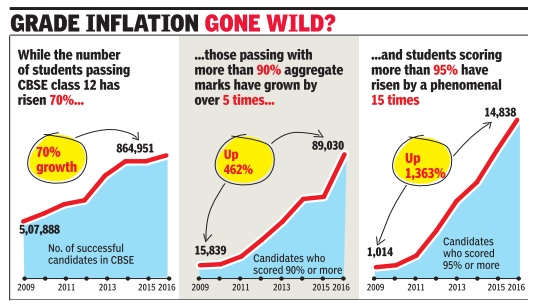
2013-17
Manash Gohain, What's behind the great Indian marks race , June 11, 2017: The Times of India
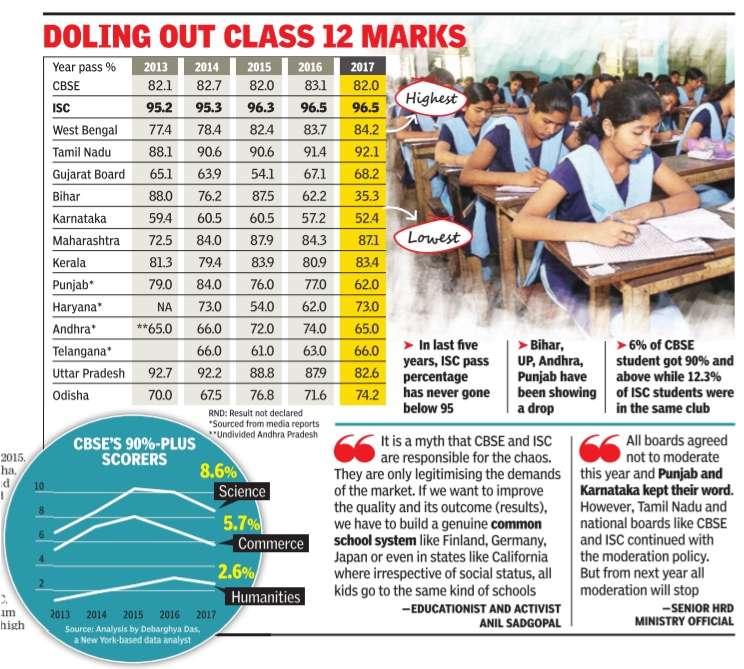
As school boards competitively inflate Class XII marks, it becomes hard to tell the best students apart
In the annual drama of the Class XII results, there are stories of cel ebration, heartbreak and injustice. The vari ation in results between various school education boards hurts students.Data over the last five years makes it clear that some boards have been competitively generous, in terms of the pass percentage as well as the proportion of high scorers (90%-and-above in aggregate).Other boards have swung in the opposite direction.
In the last five years, the pass percentage for Class XII exams conducted by the Council for the Indian School Certificate (ISC) has never dropped below 95%, while that of Tamil Nadu State Board has been above 90% since 2014.Other boards that consistently notch 80% and above in pass percentage are the Uttar Pradesh Board, Kerala Board and Central Board of Secondary Education, with West Bengal joining the league in 2015.Andhra, Telangana, Odisha, Punjab, Haryana and Bihar are on the other end of the spectrum.
And it's not just that more students are passing, they're scoring more too. In every year since 2013, over 10% of students have been scoring 90% and above in ISC.There has been a quantum leap in the number of high scorers for boards like CBSE, Kerala and Tamil Nadu as well. These four boards alone have 1,01,822 students this year who scored 90% and above in Class XII exams.
The mandate of the school education boards primarily is to set question papers and conduct fair examinations. Over the years, overzealous boards have decided to give an edge to their students, whether for entrance examinations or for merit-based admissions. Ashok Kumar Pandey , principal, Ahlcon International, Mayur Vihar and winner of National Teachers' Award 2014, says the data only con firms that students appearing for board examinations across the country have had to suffer the vagaries of examination and evaluation system. “The differences in curriculum, question paper setting and quality of evaluation have a huge bearing on the overall performance of these children,“ points out Pandey .
The variations in question papers and evaluations and, therefore, in the final results, come from the way the National Curriculum Framework (NCF) itself is understood, says Pandey . “What level of understanding and application of that topic is to be presented differs from board to board. And this is where variations at all levels crop up,“ he explains.
A common curriculum and a stronger Council of Boards of School Education in India (COBSE) could be a way forward, according to some experts. COBSE did work on a common core curriculum for mathematics and science in 2011-12, which was supposed to have been implemented by all boards but wasn't. The plan is now being revisited by the HRD ministry .
Most blame the marks chaos on the inflated merit-based cutoffs to make it to colleges and universities.
The purpose of board examination is very different from that of a competitive examination, point out experts.The board exam is used to assess how good a student is at the curriculum prescribed for the relevant classes; it is an achievement test. On the contrary, competitive examinations are a test for the elimination of weaker students. It has been seen in the past that many students who have done well in the board examinations may not do well in competitive examinations and vice versa.Therefore, using board exams alone as a means for admitting students to Delhi University or other colleges may not be ideal, since the exam is not designed for that objective.
Also, using the board examination marks to select students across various boards is discriminatory, since the marks obtained by the students depend on the syllabus, the method of teaching, scheme of examination, typology of question paper and the moderation policy followed by the board. Moderation is meant to be used to smooth any discrepancy in the result that might occur because of wrong questions, varying levels of difficulty between questions papers, and other vagaries in the examination. Under the pretext of moderation, school education boards started spiking marks, some doling out as high as 16 marks per paper.
Claiming that Delhi University was one of those responsible for the “competitive spiking of marks“, former CBSE chairperson BP Khandelwal says: “Now it's because of DU.However, it all started with BITS Pilani admissions when even the UP Board topper never used to get admission.“
He stresses that exam evaluation and its moderation process should not be guided by the university admission process. Since the situation is different in every state, COBSE should come in strongly to build a fair system. “Quality education is one of the biggest challenges and if we don't attend to it now, we will have to deal with the damage done in 2030,“ he adds.
Meanwhile, the deluge of 90-plus scores makes it difficult to judge students, and hurts the truly deserving. Grade inflation, like regular inflation, is when the same marks -say 90 -are worth less because more people are given that, explains data analyst Debarghya Das. Unlike regular inflation, it is problematic because the maximum marks you can achieve is capped at 100. He explains this with a potatoeating contest analogy. “In regular inflation, perhaps participants will be able to eat more potatoes over time because the size of the average potato gets smaller. This is okay , because the best potatoeater will still eat more. In grade inflation, I have the same potato-eating contest but the maximum number of potatoes per participant is 20. Now, as the potatoes become smaller, most of my participants eat all 20 potatoes, just like most students get 90+ marks. Therefore, as a judge, it's impossible to tell who's a true potato eating champion and who is not!“
Management of stationary sale
2017: Tuck shops can sell stationery
In a U-turn, CBSE allows tuck shops to sell stationery, August 31, 2017: The Times of India
In a reversal of its April order, the Central Board of Secondary Education (CBSE) has now allowed affiliated schools to sell “stationery and other materials required by students,“ from shops within their compounds.
The circular issued to all heads of the schools last Friday stated that in order to facilitate distribution of NCERT books, a `tuck shop' may be opened inside the premises of schools.The board in April had asked schools not to indulge in commercial activities by way of selling of books, stationery , uniforms, school bags, etc. The new circular, dated August 25, 2017, stated: “The NCERT, in order to augment the availability of NCERT books for the students of CBSE affiliated schools, has called for indent through their website for purchase of books as per the requirement assessed by the schools.“ It has also advised the schools to register and place their demands for textbooks for the academic years 2018-19 through the online portal of NCERT launched recently .
The board in its circular stated that since schools were allowed to place indent for purchase of the books directly through the NCERT website, the schools may open a `tuck shop' inside the schools' premises. The circular further stated that other materials required by students and stationery can also be sold from these shops.The circular however didn't specify the “other materials“.
’Moderation’ of the marks score by candidates
2017: Moderation limited to 3-4 marks
Moderation limited to 3-4 marks: CBSE, May 29, 2017: The Times of India
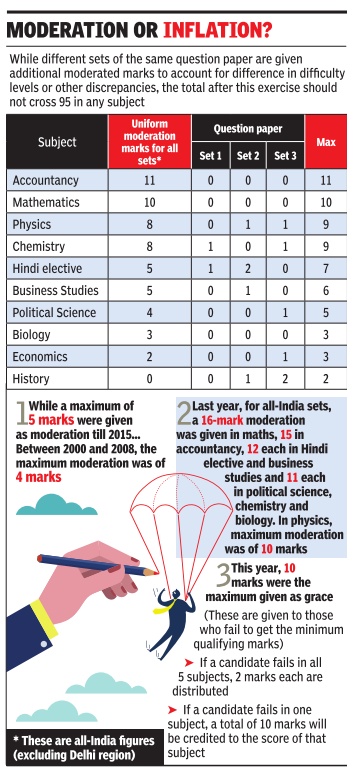
Drop in 90%+ Numbers, Rise in 95-Percenters
After capturing pole position in 2015, girls continued to dominate the CBSE Class XII results. For the third consecutive year, the all-India topper is a girl.
In fact, three of the top four rank-holders across India are girls. The seven-member elite club of 99-percenters has five girls this year. FULL COVERAGE: P 4, 5 & 6 A total of 10.2 lakh students appeared for the exam.For the fifth consecutive year, a student from Delhi-NCR topped the Class XII boards.Raksha Gopal of Amity Noida bagged the honour, scoring 498 marks out of 500 (99.6%) in humanities.
The overall pass percentage dropped by 1.03 percentage points compared with last year. Thiruvananthapuram continued to have the highest pass percentage (95.63%), while Jawahar Navodaya Vidyalayas (95.73%) were the best among institutions.
While nearly nine out of 10 girls appearing for the exam passed, over 20% of the boys failed. Girls (87.5%) maintained a lead over boys (78%) in terms of pass percentage and also bagged the top positions.Even among the top three performers in the differently abled categories, two are girls.
With a perfect 100 in three subjects -English, political science and economics --and 99 out of 100 in history and psychology , Gopal told TOI that luck plays an important role in securing good marks. Raksha said, “Hard work is essential but one has to have good luck as well. The Class XII result is not the end of the road for students. If one is relaxed and puts in hard work, they can achieve what they want.“
Bhoomi Sawant from DAV , Sector-8, Chandigarh, is the all-India science topper, and second overall, with a score of 497. Aditya Jain and Mannat Luthra, both from Bhavan's, 28-B, Chandigarh, topped the commerce stream and are joint third with 496 marks. Ajay J Raj from Thiruvananthapuram, Lakshmi PV from Palakkad (both in Kerala) and Dharshana MV from Krishnagiri, Tamil Nadu, are the three toppers in the differently-abled category with scores of 490, 486 and 483, respectively .
The other three students with 99% (495 marks) this year are Sanat Goel from Bhavan's, 28-B, Chandigarh, Ramya Kaushik of Dewan Public School, Westend Road, Meerut, and Devika C of K M B Vidya Mandir, Thrissur, Kerala.
While most trends remained unchanged, the number of students scoring 90% or more dropped for the first time in a decade to 63,247. Last year, 140 more students were in this marks bracket. However, the top continues get crowded with 10,091 students scoring 95% and above, which is 740 more than last year.
This year, just ahead of the declaration of the results, the Delhi high court had on May 22 restrained CBSE from doing away with moderation of marks. The ruling came following a decision by 32 school education boards (including CBSE) reached a consensus on April 24 on not moderating marks and spike the scores this year.
“As ordered by the Delhi HC and advised by the legal counsel, we continued with the moderation policy . However, there has been no spiking of marks which is evident from the number of 90% and above scorers, which has otherwise been increasing for last 10 years,“ said a senior CBSE official, while stating that moderation has been restricted to three or four marks in 2017.
2017, incidents: ’Moderation’ of the marks score by candidates
In 2016, CBSE gave 16 `extra marks' in maths , May 18, 2017: The Times of India
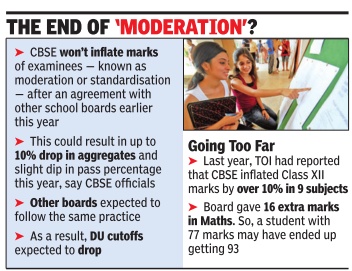
As first reported by TOI, CBSE gave as many as 16 extra marks in the Class XII Maths exam in 2016 in the all-India set of papers and 15 marks in the Delhi set during the process of `standardisation'.
In nine subjects, marks were `standardised' by more than 10%. As a result, a stu dent with 77 marks in mathematics may have ended up getting 93 marks.
In 2016, the pass percentage for CBSE had touched an all-time high of 83.05% and over 80,000 students scored 90% and above.
While moderation of marks has always existed to even out different levels of difficulty and other factors in an exam of such huge scale, sources said the exercise was conducted judiciously in the past. “It would never lead to an increase of more than five marks,“ said a former CBSE chairman.
Following reports of a spike in marks via moderation last year in 2016, former CBSE chairman Ashok Kumar Ganguly called upon the HRD ministry and Council of Boards of School Education in India (COBSE) to intervene.
Huge jumps in marks being given both via `moderation' and 'grace' liberally, according to the former CBSE chief, which was “against the spirit of moderation“.
CBSE awards up to 11 extra marks in a subject
Board Also Raised Grace Limit To 10Earlier, Only 1-3 Marks Used To Be Added
Ordered by the court to restore moderation of Class XII marks this year, the Central Board of Secondary Education (CBSE) seems to have gone way beyond reasonab le limits of the policy while awarding marks. Up to 11extra marks were given in accountancy , 10 in mathematics and eight each in physics and chemistry , documents accessed by TOI reveal. This is apart from set-wise moderated marks awarded due to differences in difficulty levels and other discrepancies. The spiking, evidently done in anticipation of other boards doing the same, is bound to reopen the moderation debate.
One expert called it “not moderation, but competitive inflation“ of marks. Others said spiking of marks was putting an otherwise progressive policy (moderation) under a cloud, with all boards getting into competitive mode. CBSE also gave up to 10 marks as gra ce to candidates who failed to get qualifying marks. TOI accessed documents on CBSE's moderation process this year for all India sets of question papers for 18 subjects. There were set-specific ex tra marks given to the same question paper(s).For example, while physics has been awarded eight marks as moderation, for `set 2' and `set 3', an additional one each has been awarded. Speaking to TOI, former CBSE chairperson Ashok K Ganguly said that such variability in mean marks among different sets of question papers should not have arisen in the first place. “These cannot be moderation of marks if the process has been done properly . Earlier, moderation of one to three marks used to be adequate,“ he said.
Stating that moderation is a necessity for a national board such as CBSE, Ganguly said it should be done judiciously .“State boards should not be moderating at all,“ he added.CBSE had stated it would not moderate marks this year.However, on May 22, 2017, the Delhi high court overturned the decision. Following the court's order, CBSE continued with its “moderation policy“ and the Class XII results were notified on May 28, 2017.
The board's grace marks policy (for those candidates failing in a subject) too was `liberalised' this year. As per CBSE documents with TOI, a total of 10 marks were awarded to candidates as grace. According to a former controller of examination, “grace marks used to be three or maximum four till around 2009“.
In the wake of this year's moderated marks, a former CBSE chairperson has called for reviving the Council of Boards of School Education in India (COBSE), a voluntary association of all the school boards. “It seems that COBSE has become dysfunctional. Its mandate was to create a levelplaying situation. The body should be revived and the human resource development ministry should intervene, along with state education ministers, to ensure that the 2018 board results are different,“ he said.
The ministry of human resource development and the CBSE have not been on the same page over the decision to do away with moderation even though the ministry agreed various boards were “spiking“ marks. But the ministry's view that the decision be implemented from next year to avoid complications did not find favour with the CBSE.
The ministry is similarly worried that the decision only to re-total and not re-evaluate has been taken without taking into consideration the interests of students and may create resentment if it was not fully explained.
In the moderation controversy , ministry was able to prevail on the CBSE not to challenge the high court decision in the Supreme Court so as to avoid a delay in declaration of results. But the board, an autonomous institution under the MHRD, did not heed caution in announcing scrapping of moderation. According to HRD sources, the ministry and the board had major differences as the minister asked CBSE to work on the policy only after detailed consultation and implement it from 2018.
A former CBSE Chairman’s view
Ashok Ganguly, Make moderation process transparent, May 25, 2017: The Times of India
Don't ban it if you want to rid the exam system of discrepancies
The problem today is that the school examination system has also become a victim of consumerism. In a social milieu that values marks more than the development of personality , it is not `learning' but `scoring' that gets glorified. Besides, when a system relies on elimination rather than selection for higher studies and even for jobs, there automatically is a race for marks. So even if a student gets 94%, his parents are not happy and they want the result verified.
With a steady decline of high er education across the country , Delhi University remains a hope for today's youngsters. The main reason why marks of Class XII board examinations started being inflated was because Delhi University follows a process of elimination rather than selection for admission in undergraduate classes. Inflation of marks became more pronounced after 2008 when some state boards began increasing marks to help their students get an upper hand in the elimination process.
If the design and blueprint of the question papers of the country's 52 school boards -three national, the rest state-based -were flawless, then the performance of the students would show a normal probability curve or, at most, a bellshaped one in graphical representation. In such a situation, 4-5% students would get 90% marks or above. However, in some state boards, 25-30% of the students get 90% or more in some subjects, particularly English. Is this normal? And why English? Well because, English is one of the best four subjects considered for admission in undergraduate classes.
Only in this background is the decision of CBSE and some of the state boards not to allow moderation marks a welcome step. But I do not know how this will be implemented and which agency will monitor it. Some state boards have already declared their results and they have allowed moderation.
Moderation is usually done in three stages to minimise discrepancies in the system: first, moderation of question papers; second, moderation of marking schemes; and finally , moderation of the raw score, if necessary . Moderation should exist in some form, but must be full-proof and transparent. Once, the question papers were set by people from universities and colleges and moderation of marking schemes was done by practising schoolteachers.
Moderation is a scientific process and as long as moderation of question paper and moderation of marking scheme are done appropriately, there won't be any need for any moderation of marks in the third stage. And if at all moderation marks have to be awarded, they should only be 3-5 marks, depending on the difficulty level of a particular question paper set. It can never be awarded to students en masse in any subject.
At the root of all efforts to stop the inflation of marks in our ex amination is the issue of raising the awareness, confidence and competence of all stakeholders. If moderation is not implemented in the true spirit by all boards but only by a few, the latter's students are going to suffer in the by cut-throat competition. We have come to believe that the board examination is Aladdin's lamp and if we rub it, we will be able to materialise the genie that will, at our command, fulfill our wishes for the right marks, good college and a bright career. This genie has to be exorcised and it cannot be accomplished by cribbing with a fragmented view of the system.Highlighting unfortunate aberrations thrown up by the system serves no purpose except perhaps to heighten the fear perception and hysteria among young minds.
The writer is an educationist and former Chairman of Central Board of Secondary Education
Principal, Appointment of
December 2016: CBSE gets a say in unaided schools
Manash Gohain, CBSE gets say in picking heads of unaided schools, Dec 23, 2016: The Times of India Private unaided schools affiliated to the Central Board of Secondary Education (CBSE) will no longer be able to appoint principals or heads on their own as the board has empowered itself to monitor such appointments in schools that fall under its ambit. Also, teachers aspiring to be principals will now have to qualify a Principal Eligibility Test (PET) conducted by the board, a circular said.
According to a CBSE circular issued to all state education directorates, school principals and other stakeholders, it will now be mandatory for schools to include a CBSE nominee and a state government nominee in their selection committees for principals.
Further, these committees will have to comprise five or more members instead of the four that were required till now, the new addition being that of the state government nominee. What makes this change significant is that the member with experience in school administration, hitherto nominated by schools' managing committees, will now be nominated by the chairperson of the CBSE.
This effectively means that out of the five members on the panel, two will be appointed directly by , or with the approval of, the CBSE.“Till now, it was the managing committee which used to independently pick the two, with the president of the society and the managing committee chairperson being the remaining two constituents. In case of pri vate unaided schools, the recruitment used to be completely in the hands of the school management,“ said a member of the central board's governing body .
Voicing concern at the apparent curtailment of autonomy , a principal of a private school in Delhi said on condition of anonymity , “This effectively creates a controlled regime. We don't really know how reducing schools' members in the selection committee will help them. The strength and kind of candidates vary from school to school. For that there should have been more autonomy . The CBSE and state government nominees are welcome, but that may result in delays.“
Re-evaluation policy
Students can seek re-evaluation in all subjects: HC
Abhinav Garg, No Cap, Students Can Opt For All Subjects, Feb 05 2017: The Times of India
In an important verdict, the Delhi high court has struck down the Central Board of Secondary Education's selective re-evaluation policy that restricted students from availing the option in just 10 subjects and 10 questions per subject.
Spelling relief for students, a division bench comprising Chief Justice G Rohini and Justice Sangita Dhingra Sehgal termed the restrictions as “eccentric“ and said students can now seek re-evaluation in all subjects.
“It is rather eccentric to first provide for the facility of re-evaluation to the candidates and thereafter put unreasonable restrictions. The board cannot afford to ignore individual claims of re-evaluation at its whims or fancy , by merely `pick and choose' of subjects or number of questions,“ the bench observed while ruling in favour of two students.
The board had introduced a rule in its examination scheme to allow students to apply for re-evaluation, but restricted the number of questions and the subjects to be re-evaluated. By way of a notification in May 2015, CBSE brought out these rules after amending the by-laws, which the court found to be “manifestly unjust, unreasonable and partial“.
Pointing out the pitfalls of CBSE continuing with such a rule, the bench observed that it “would lead to discontentment and frustrations if the students who put in a lot of effort do not get the results they expect“ adding that “it should be the students' prerogative to get their answer sheets re-evalua ted in order to ensure proper assessment is done“.
In the process, the court upheld two separate single-judge verdicts. In one a single judge had faulted CBSE for allowing just 10 questions for re-evaluation, while the second bench ordered it to re-evaluate a student's physical education theory paper, despite the board claiming that PE is not covered under its subjects where re-look is permitted.
The board argued before the division bench that it sto res lakhs of copies after the examination, as many students apply for re-evaluation. Defending its restriction on number of questions and number of subjects, CBSE maintained it had to exercise some discretion, else will be flooded with such requests. It even cited certain Supreme Court judgments, to bolster its argument that it has the power to deny reevaluation of answer sheets.
However, the HC rejected its stand and noted that administrative difficulties of the board can't over-ride the future of a candidate.
CBSE had decided to scrap the re-evaluation of class XII answer sheets in 2016 and the court order is a setback. In 2014 it introduced re-evaluation in eight subjects, which it extended to 10 in the subsequent year, becoming the only board to facilitate this service.
There is a three step process wherein the student first needs to apply for recounting of marks if in doubt and thereafter he she can ask for the photocopy of the evaluated answer sheets. If not satisfied, the third step is re-evaluation of the answer sheet. All the three steps are linked and a student can't ask for re-evaluation without following the preceding two steps.
Re-evaluation reveals major errors in totalling
Jun 18 2017: The Times of India, June 18, 2017
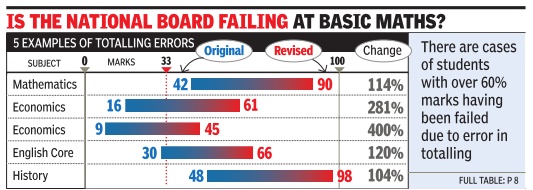
Up To 400% Difference In Original And Corrected Marks Raises Questions
Experts Say Re-Evaluation Need Of Students
A senior CBSE official admitted that the number of applications for verification of marks has been unprecedented, although he didn't reveal the exact number.
This raises two important questions. First, what is wrong with the totaling process and how fair is it for the CBSE to do away with re-evaluation altogether? CBSE currently only al lows verification while re-evaluation is possible only after a court order.
Ashok Pandey , chairperson of National Progressive Schools' Conference, an association of over 200 leading private schools in the country, strongly favoured a relook a the CBSE decision to scrap re-evaluation. “It is in the best interest of the students. CBSE, being the premier school education board in the country , should definitely take a lead in doing enough to bring in transparency,“ said Pandey .
Sonali, whose marks increased by 27 (from 68 to 95) post verification, pointed out that unlike her, students who were not very confident or scared didn't even bother going for the verification process. “As I wanted to pursue Economics (Honours), I had no option but to go for verification. However, many others didn't apply out of fear or thought that nothing will happen out of this exercise,“ said Sonali.
A senior official with the CBSE exam branch, while agreeing that there were mistakes in the process, said that the difference could be due to various reasons -mis takes in totaling of marks, incorrect transfer of marks to the title page (the front of the answer books) and detachment of supplementary answer books.
Parents level another criticism, saying that the CBSE's decision to link the two processes verification and obtaining photocopy of the evaluated answer sheet is anti-student. At present, only students who apply for verification can get a photocopy. “All students should be allowed to obtain their evaluated answer sheets and then if they want, they should be allowed to apply for re-evaluation,“ said a parent on anonymity .
2014: Top scoring subjects
The Times of India, Aug 30 2015
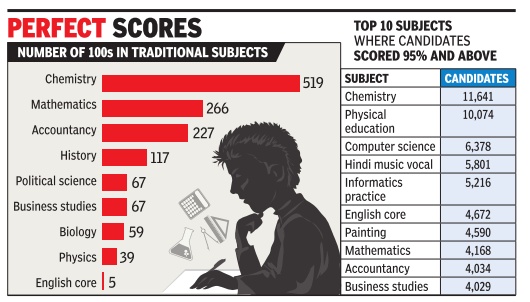
Manash Gohain Chemistry was a cakewalk for students at the Class XII Boards this year. Data on subject-wise scoring pattern from the Central Board of Secondary Education, exclusively accessed by TOI, revealed that not only were a maximum number of 100s scored in chemistry but that over 11,000 candidates also got 95% and more in the subject. The trend of high scores have continued with the number of 100s this year crossing 2,300, up from over 1,900 in 2014. The data also debunked the myth that it's easier to score in vocational electives. Mathematics, English, accountancy and business studies were among the top 10 subjects in which students scored a perfect 100 as well 95% and above. Another highlight: As many as 117 notched up a perfect score in history--a larger figure than physics, biology or business studies this year.
According to CBSE sources, the number of 100s scored among the traditional subjects--chemistry , physics, biology , mathematics, English, accountancy, business studies, history and political science--this year is 1,366. This is despite claims by schools and students that the physics and mathematics papers have been the “toughest“ in a decade. A total of 266 students scored 100 in mathematics and 39 did the same in physics.
The number of candidates scoring 95% and above in individual subjects has also been significant. Candidates have scored 95% and above in 95 subjects out of the total of 193 subjects offered by CBSE at the senior secondary level.
“In all mainstream subjects and well as in popular subjects, students seem to have performed well. Subjects like economics, Hindi core, history, political science, geography are also among the top subjects in which more than a thousand candidates have scored 95% and above. There are 10 subjects in all in which over 4,000 candidates scored 95% and above,“ said a senior official.
One of the reasons for the spike is the grace marks doled out. “Grace marks is nothing new, but this year it has been a bit on the higher side,“ said another CBSE official.
Class X
Results, 2016
The Times of India, May 29 2016
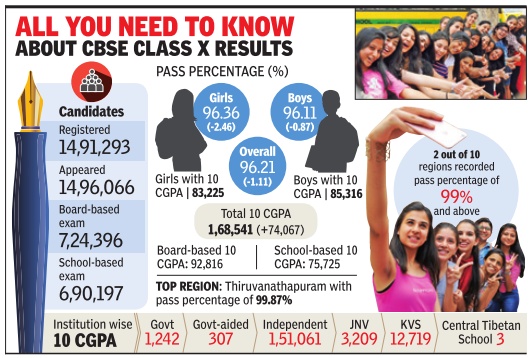
Manash Gohain
The capital had little to cheer about after the CBSE Class X results were declared on Saturday as it recorded the second-lowest pass percentage of 91.76% among all 10 regions. Thiruvananthapuram (99.87%) held on to the top spot. Overall, the pass percentage fell a point from 97.32% last year to 96.21%, though the number of those scoring a cumulative grade point average of 10 crossed the 1 lakh mark for the first time.
Girls outshone boys, albeit by a tiny fraction, after the latter had overtaken them last year. Among the girls, 96.36% cleared the exams compared with 96.11% of the boys. However, the boys held the edge in scoring high grades, with 85,316 of them logging a CGPA of 10 against 83,225 girls scoring the highest grade.
In fact, the number of those obtaining the highest CGPA of 10 rose 40% from that of 2015. A CGPA of 10 represents all those obtaining aggregate marks of 95% or above. For the first time, the number of students crossing the coveted mark went beyond 1lakh, with 1,68,541candidates eventually getting a CGPA of 10. With the introduction of continuous and comprehensive evaluation since 2009, the Class X board exams have become optional. This year, nearly 52% of the candidates opted for the school-based exam. This also means that students wanting their answer scripts to be verified would have to apply separately according to the exam they sat for. According to K K Choudhury , controller of examination, CBSE, students who took the school-based exam would have to apply for verification of grades at their respective schools. For those who took the board-based exam, applications are to be made online within seven days from the declaration of results.
Interestingly, students with a CGPA of 10 outnumbered those getting any other grade. While last year, 7.1% of the candidates had got to a CGPA figure of 10, the number went up to to 11.91% this year. Candidates from private school continued to lead the pack of top scorers with 89.62% of CGPA 10 scorers, a marginal improvement over last year's 89%.
Regionwise, Thiruvanan thapuram again led at the top with a pass percentage of 99.87%. Chennai is the only other region with 99% and above pass percentage among the 10 regions.
The number of attempts permitted for the improvement of grades in Class X has been reduced to one from five since 2013. Candidates can appear for the improvement exam in July .
Of a total of 3,510 diabled candidates, 3,335 qualified with a pass percentage of 95.18%. The server was down for nearly 40 minutes as soon as the results were released.
6 compulsory subjects: 2017-18
6 papers mandatory for CBSE Class X exam in vocational stream, March 10, 2017: The Times of India
HIGHLIGHTS
The CBSE has remodelled its assessment scheme for Class X Board examination.
From the 2017-18 academic year, it will be compulsory to study a vocational subject for students.
A candidate will have to score 33% marks in both board exam and practical exam to pass the subject.
NEW DELHI: Students appearing for Class X board exams in vocational stream will have to study six subjects instead of five with the CBSE remodelling its assessment scheme. Class X students have to presently study five subjects — two languages, social science, mathematics and science.
Students also have a choice of studying a vocational subject as an "additional" course.
However, from the 2017-18 academic year, it will be compulsory to study a vocational subject for students opting for the particular stream. The Central Board of Secondary Education (CBSE) has remodelled its assessment scheme for Class X Board examination for schools offering vocational subject as compulsory subject under the National Skills Qualifications Framework (NSQF).
"If a candidate fails to pass in any one of the three elective subjects -- science, social science, mathematics, then it will be replaced by the vocational subject (offered as sixth additional subject)," a CBSE circular said.
"The board exam result will be computed accordingly. However, if a candidate desires to reappear for the failed subject they can appear in the compartment examination," it added.
Students will have 13 options to choose from for the sixth subject -- Dynamics of Retailing, Information Technology, Security, Automobile Technology, Introduction to Financial Market, Introduction to Tourism, Beauty and Wellness, Basic Agriculture, Food Production, Front Office Operations, Banking and Insurance, Marketing and Sales, and Health Care Services.
According to the circular, the maximum marks will be 100. Out of the total 100 marks, the board exam will be of 50 marks, and 50 marks are allocated to internal assessment/practical examination.
A candidate will have to score 33 per cent marks in both board exam and practical exam to pass the subject. In another major decision, the CBSE has decided to do away with seven Academic Electives and 34 vocational subjects for Class XII because of low enrolment numbers.
Boards again from March 2018
The Times of India, Dec 21 2016
CBSE Std X board exam will be back from March 2018
The governing body of the Central Board of Secondary Education (CBSE), the highest-decision making body of the board, approved the restoration of the Class X board examinations, paving the way for the return of the public exam after seven years. Class X students in the coming academic year will take the board exam in March 2018.Final marks will give 80% weightage to the exam and 20% to internal assessment.
Since 2011, after the introduction of continuous and comprehensive evaluation (CCE) in 2009, the CBSE made the Class X board exam optional, which meant students studying in senior secondary schools had the option to sit for the school-based exams.
The board conducted a survey among various stakeholders and the majority were in favour of the Class X board exams. Thereafter, the HRD ministry announced the rollback of the optional scheme of the present Class X exam system. “It was a unanimous deci sion of the members of the governing board. The matter was discussed threadbare and in principle it was decided to restore the exams scheme of the pre-CCE period. A circular to the effect on details about the examination, which will commence from 2018, will be shared with schools soon,“ said R K Chaturvedi, CBSE chairperson.
He confirmed that 20% weightage will be given to internal assessment by the schools. “Members welcomed the decision,“ said Jyoti Arora, member of the board's GB and principal of Mount Abu Public School.
The 2016-17 batch of Class X students will continue to follow the existing format where both school-based and board-based options will be open.
Class XII
Class XII results: historical trends
CBSE is India's Central Board of Secondary Education
Results, 2016
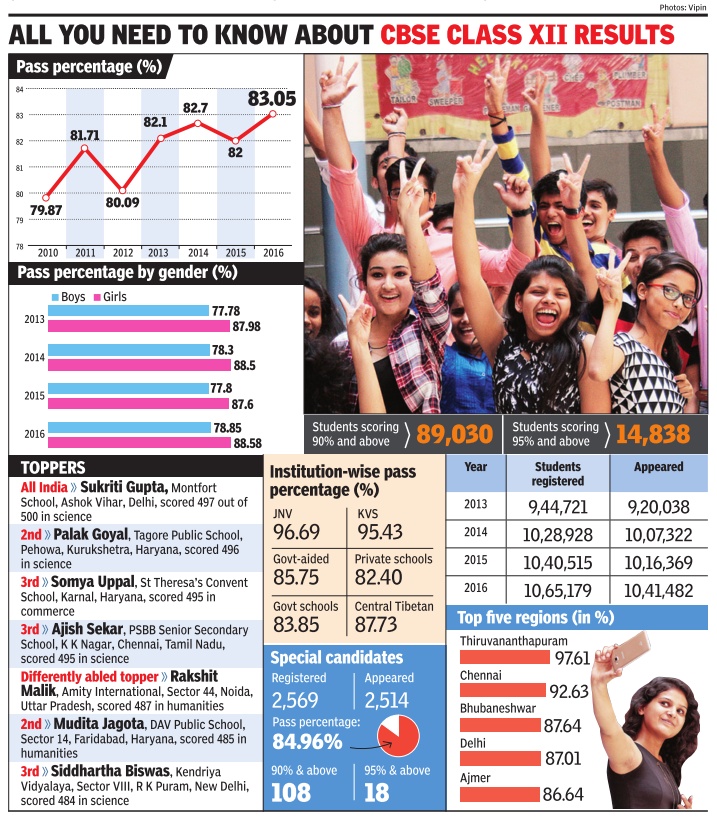
Delhi’s performance
The Times of India, May 22 2016
Delhi pass percentage better, but slips to 4th
Delhi's pass percentage, 87.01%, is better than the national average and is even an improvement over 86.13% in 2015. However, on the list of regions, the national capital has slipped to the fourth position from the third slot it got in 2015.
Governments schools have once again had a higher pass percentage than private ones--88.98%--against 86.67%. Both groups have seen slight improvement in performance compared with last year. Girls have done better than boys this year too. Besides, Kendriya Vidyalayas have outperformed others.
The national top-scorer in science is from Delhi; as is one of the top-three in the differently-abled category , but on the whole, many private schools may have seen a slight dip in average scores thanks to disappointing maths scores and wide variations in subjects such as economics and political science.However, there are still dozens with aggregate scores at or above 95%. Amity International, Mayur Vihar, has 65; Delhi Public School, Vasant Kunj has 63; DPS Dwarka, 57; Sardar Patel Vidyalaya, 35; Springdales School, Pusa Road, 27; Birla Vidya Niketan, Pushp Vihar, 25; Amity Saket, 18; Ahlcon International School, Mayur Vihar has 15; Mount Abu Public School, Rohini, has 11; and Manav Sthali School, five. There is a last number who've scored above 90% too; DPS RK Puram alone has over 500 of them.
Full marks are rarer in some subjects this year but still present in spades. The Indian School has 13 kids who've scored full marks in a subject. Springdales, Pusa Road has 11; and Ahlcon International, nine. “This is extraordinarily good,“ said Tania Joshi, principal, The Indian School, adding that there were “wide variations in performance“ in several subjects.
The CBSE hasn't released the name of the top rank holder for humanities. The humanities topper for Delhi isn't available either but Tarang Kaur of DPS RK Puram, with an aggregate of 98.2%, is a likely candidate.Ayush Srivastava of Amity International, Mayur Vihar, has come close to the top score in science with 98.6%.
It has been a decent year for economically weaker section candidates as well. Nida Khanam, daughter of an imam and supported by the alumni of the Modern School, Barakhamba Road, has scored 95.6% in the board exams. “My family has had to face a lot of crisis all through the years. Before this, I studied in a government school and always topped. But unlike that school, there was a high level of competition here,“ said Nida. She has scored a 99% in English.
KVs and JNVs continue to excel
The Times of India, May 22 2016
KVs and JNVs lead the pack with maximum passing out
The two central government-backed school chains, Kendriya Vidyalayas (KVs) and Jawahar Navodaya Vidyalayas (JNVs) continue to excel when it comes to pass percentage in the exams conducted by the Central Board of Secondary Education (CBSE).
In 2016 too they led the pack in the “best pass percentage“ category . Also, one of the toppers in the differently-abled category is from the KV system. CBSE XII results were announced.
In 2016, 70,328 students from KVs appeared for Class XII exams as against 27,413 from JNVs. JNVs recorded a pass percentage of 96.69%, a marginal drop from 96.82% recorded in 2015. Institutionwise, KVs recorded the second best pass percentage with 95.43%, up from last year's 94.72%. Siddhartha Biswas from KV , R K Puram Sector VIII scored 484 out of 500 in science.He is one of the toppers in the differently-abled category .
While the pass percentage of other institutions was hovering around 80s, the KVs and JNVs had breached the 90%mark way back in 2009. In fact, KVs and JNVs recorded 97.4% and 97.5%, respectively , in 2014, which is so far their best performance.
Caste-category wise performance
The Times of India, May 22 2016
Kshitiz Gaur
Only 1,827 ST girls took XII exams
For the first time, the CBSE declared results of the Class XII board examinations offering castebased data. Students were divided into general, SC, ST and OBC (Other Backward Caste) categories.
Educationists were surprised by this novelty. Not surprisingly, the best performers were from the general category. The data released by the board also showed that only 1,827 girls from Scheduled Tribes took the examination this year.
The results showed that 88% of students in the general category passed; 82.60% of Schedule Caste students and 82.70% of Other Backward Castes candidates secured pass marks.Only 80.50% of students of Schedule Tribes managed to pass. Some board officials, who too wished to remain anonymous, told TOI that the caste data of examinees would aid in comparing the educational performance of different social categories.
